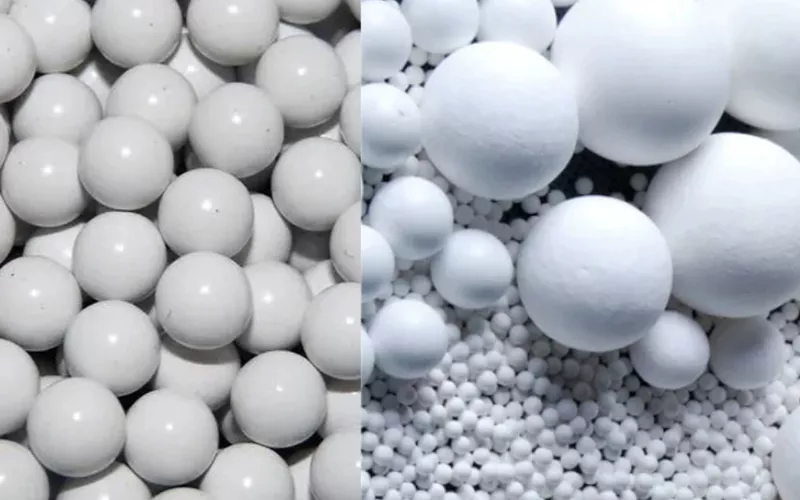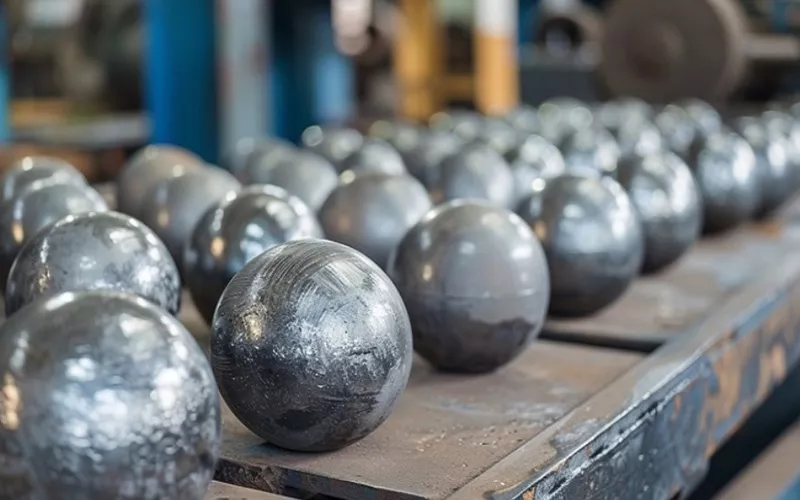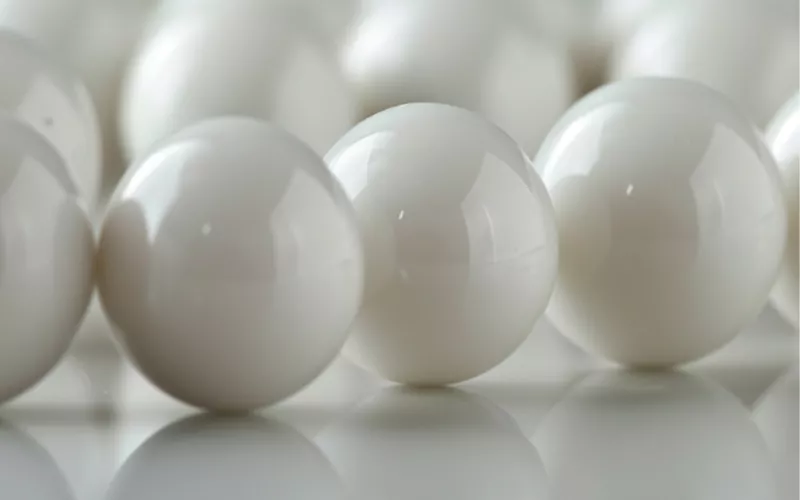Einführung
Do you desire cleaner milling, extended life, and consistent product quality? Alumina grinding balls provide such a balance, offering both a high level of hardness and low wear. The result? Fewer media changes take place, less contamination, and more stable outputs between mills and dispersers. So, that’s why it is reliable across various industries.
What are Alumina Grinding Balls?
Alumina grinding balls (alumina balls or ceramic grinding balls) are high-density ceramic balls created out of Aluminiumoxid. They are pure (92 percent to 99 percent Al₂O₃). You mill, mix, and disperse them in ball, attritor, and bead mills within numerous industries in the world.
Why Industries Are Switching From Steel To Alumina
Once, I went to a ceramics factory, and the maintenance manager gave me a look at their worn-out steel media. The balls were pitted and irregular, resulting in defects in the product. When changed to alumina, they lasted months before being changed again. The distinction was evident in quality and idle time.
The conventional ones have been steel balls, but nowadays, more plants are switching to alumina grinding balls. You achieve an improved wear performance, reduced contamination, and service life. Such changes are significant in industries whose profits are based on purity and efficiency.
Steel media have the capability of shedding particles into your product. That increases the levels of contamination, particularly in paints, pharmaceuticals, Und Keramik.
Aluminum oxide balls do not have such a problem because their composition is inert. They maintain chemistry batch-to-batch on products.
Increased wear resistance of balls in mining and mineral processing means fewer shutdowns due to the need to recharge the mills. That saves wasted working hours.
Alumina ceramic grinding balls may cost more in the form of an upfront purchase. But they reduce the frequency of replacing them, so the cost is balanced in the long run. In processes where the purity of material is vital, the switch can enhance adherence to industry requirements and minimize wastage.
Performance Advantages
Alumina ceramic grinding balls have the following operational benefits:
-
High hardness: Around 9 on the Mohs-Skala, hard to deform and wear out even under heavy loads of milling.
-
Low contamination: Alumina balls do not generate a lot of debris as compared to steel; the product chemistry remains constant.
-
Stable milling output: These balls are able to control particle size on repeated batches.
-
Reduced downtime: Ceramic grinding balls have a longer lifetime means no more stoppages to change media in the mill.
In one pharmaceutical plant I have visited, the contamination problem with steel balls resulted in stopping production every day. Aluminum oxide balls solved this issue at that time, and the operators did not need to spend time performing ongoing repairs. They could easily concentrate on production.
Cost And Lifecycle Benefits
Typically, when you consider the lifetime, alumina milling balls have a lower cost than steel grinding balls. Initial cost will be higher, but they last longer, fewer replacements, and labor cost of recharging mills will be lower.
One of the plant managers told me that they have reduced shutdowns by half when they switched. That additional uptime was more than making up for the premium up-front cost. Energy was also reduced since the balls remained efficient longer.
You also save the cost of energy. Reduced wear rate aids in efficiency in the mill, which also means less power is required to achieve a certain throughput. In plants that are kept under close maintenance schedules, this reliability is cost-saving and production planning friendly.
I have visited ceramics plants noted saving 25% in the energy costs after implementing the use of alumina grinding balls. According to the operators, the balls ran well even when dry milling at high speeds, and steel could not withstand this.
With alumina ceramic grinding balls you have consistent predictable both in terms of performance and cost over long spans of production time.
Key Technical Properties Of Alumina Milling Balls
The alumina grinding ball reaches around 9 levels of alumina Mohs hardness, near that of diamond. Thus, it is wear-resistant in a rough environment. They are relatively dense (3.6 g/cm³ ) to impart high impact energy without bringing too high a weight.
They also have high specific gravity, providing high efficiency in grinding both wet and dry. They have thermal stability at temperatures greater than 1500 °C, so you can employ them in high-temperature milling even without fear of their structural integrity failing.

Alumina Ball Manufacturing Process
The following is the step-by-step alumina ball manufacturing process:
Step 1: Selection of Raw Material
It starts with high-purity alumina oxide powder (Al₂O₃) material to directly influence the quality and performance of final alumina balls.
Step 2: Milling of Raw Material
This powder of aluminum oxide can be milled by a ball mill or other mill equipment. Milling makes the particles small and uniform, which is important in a firm shaping and density during subsequent processes. The next can also be subjected to the addition of binders or plasticizers to improve formability.
Step 3: Spray Drying
Slurry has been milled and is sprayed into a dryer with the help of hot air, where the moisture is eliminated. In this process, the moisture content and particle size of the granulated powder produced are uniform.
Step 4: Shaping (Forming the Balls)
There are two main streams on how shaping can be carried out:
-
Isostatic Pressing: The powder is put into a pliable mold and pressed from different sides evenly at high hydraulic pressure. The impact of this is that it produces high density and low defects.
-
Extrusion and Cutting: Powder, which is mechanically extruded to obtain a cylindrical shape and then cut into spherical size, is further processed.
Step 5: Drying of Shaped Balls
The formed balls have traces of wetness from the binders or the processing. After eliminating this moisture, they are put in controlled temperature drying ovens. This is completely removed to avoid cracking or deforming during the firing process.
Step 6: Sintering (Firing at High Temperature)
The dried balls are sintered in high-temperature kilns (usually to higher than 1500 °C). Sintern causes the particles to become fused, enhances hardness, strength, and density, and decreases porosity.
Step 7: Finishing (Precision Grinding and Polishing)
Balls can be irregular to some extent after sintering. These are precisely ground and polished to attain the exact requirement of diameter tolerance and required roundness performance requirement.
Step 8: Quality Control and Testing
Every batch is tested on:
-
Density (to make sure there are no internal voids)
-
Mohs hardness (to affirm wear resistance)
-
Wear rate (to check performance during milling)
Applications that require corrosive materials may also have chemical stability tests.
Step 9: Packaging and Dispatch
The alumina ceramic grinding balls are cleaned, graded, and packed depending on the size and specifications of the clients. They are packaged, and thus they are not contaminated or damaged during transport.
Common Industrial Applications of Alumina Balls
Alumina grinding balls can be applied in many industries where efficiency and purity are critical. Here are some alumina balls uses:
-
Mining industry: Ceramic grinding balls for ball mills enhance efficiency in the ore processing. This is due to the high hardness and wear resistance decreases the downtime and increases the cycle of milling. So, it reduces the cost per ton of the processed ore.
-
Paints and coatings: Alumina milling balls provide consistent dispersion. It avoids metallic contamination that will alter the color or finish. As a result, it improves the stability of the product during long storage.
-
Pharmaceutical milling: It can keep any active ingredient/excipient pure throughout the manufacturing process. While controlling contamination, ensuring compliance with the regulations, and guaranteeing the safety of the product.
I once witnessed a paint manufacturer who was battling with the problem of color difference. This is due to contamination by a steel ball. Using alumina balls in place of them stabilized the pigment, preventing a batch write-off and wastage.
Comparing Alumina To Steel Grinding Media
When you compare alumina high density grinding balls and steel media, three main points direct your decision.
|
Factor |
Alumina Grinding Balls |
Steel Grinding Media |
|
Wear Rate |
Ceramic grinding balls have a very low wear due to ~9 Mohs hardness, maintaining performance longer in abrasive conditions. |
Higher wear rate, especially in abrasive or corrosive processes, leading to frequent replacement. |
|
Contamination |
Chemically inert, prevents changes in product color, taste, or formulation. |
Can release iron particles, risking contamination and altering product properties. |
|
Cost Per Cycle |
While the alumina balls price is higher upfront, but longer life reduces maintenance costs and downtime. |
Lower initial cost, but frequent replacement increases long-term expenses. |
|
Process Stability |
Maintains consistent particle size and chemistry over multiple production runs. |
Performance can degrade as wear and contamination accumulate. |
In processes where steel balls are replaced by alumina grinding balls for ball mills, these facts usually justify the change. It depends on what amount of contamination you tolerate, maintenance schedules, and whether uninterrupted production is worth anything to you.
How To Choose The Right Alumina Grinding Balls
By matching the size, purity and choosing dependable suppliers, you guarantee the efficiency of your performance in the milling process.
-
Match Size To Process: Selecting the alumina high density balls should begin with matching the size to your mill and product requirements. The smaller-sized balls provide smaller particle sizes, and the larger ones offer increased grinding efficiency to coarse feed materials.
-
Select Correct Purity Grade: The high purity (99 percent) alumina balls minimize contamination and are best suited for pharma and electronics. Whereas, the mid-range purity (92-95 percent) is best in mining, ceramics, and general milling.
-
Check Supplier Reliability: Select the high density alumina grinding balls suppliers with record of quality control, request material data sheets, and test reports. Verify that they can supply the amounts you need just when you need them.
-
Assess Total Cost Impact: Align the ball preference with your schedule, maintenance, and contamination tolerance to get a more efficient management of your costs.
Why Choose GORGEOUS for Alumina Grinding Balls
Here are the reasons why you need to choose us:
-
Unmatched Purity for Superior Milling Results: As a reliable alumina grinding balls manufacturer USA, our alumina balls are made at purity levels that maximize results. This is because of reduced contamination concerns (high purity 99 percent Al₂O₃). So, it is best in industries where the use of unnecessary chemicals could be sensitive, like the pharmaceutical and ceramics industries.
-
High Wear Resistance for Longer Lifespan: High wear resistance ensures the grinding balls last longer without exposure to harsh circumstances in the mills. This means less frequent replacements, downtime, and cost savings in the long run. That’s the reason we are the top alumina high density balls supplier Europe.
-
Precision-Engineered for Consistent Performance: Each ball is ensured to behave with repeatable accuracy by manufacturing under stringent dimensional controls. It maintains smooth milling, consistent particle size reduction, and optimal milling efficiency within a ball charge.
-
Flexibility Within the Various Industries: Our alumina grinding balls can be used in a variety of industries, whether it’s mining, ceramics, electronics, or specialty materials. Our alumina grinding balls can fit in specific applications and remain exceptionally reliable.
-
Reliable Supply and Timely Delivery: With low density and high strength, our balls can be milled faster and require less energy. In return, it saves you operational costs while maintaining the same performance.
-
Technical Support and Timely Delivery: Our support professionals will give personal suggestions regarding your milling process, material, and efficiency targets. We collaborate with you to achieve the best outcomes. We will always keep a strong production base, as well as efficient distribution and delivery.
Abschluss
Alumina grinding balls are superior to steel in terms of general durability, purity, and performance. This made them an ideal solution in industries that believe in precision and cleanliness. Know your milling needs and compare the essential characteristics to make an informed decision to maximize efficiency and product quality.
Want to take your milling to the next level? Contact GORGEOUS today and acquire high-end alumina grinding balls that have stood the test of time in various industries globally.
FAQs
Why choose alumina over steel?
Alumina is not only lighter and does not corrode easily, but it also decreases contamination during milling. Hence, applicable in industries where purity is required.
Can alumina grinding balls be reused?
Yes, with proper cleaning and maintenance, alumina milling balls can be used repeatedly and regain efficiency.
What industries use alumina high density grinding balls?
They are largely used in ceramics, mining, pigments, pharmaceuticals, and chemical production.
How do I select the right size?
Choose according to the milling equipment, the raw material type, and the required particle size to obtain the best results.


